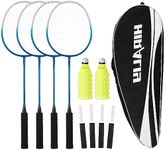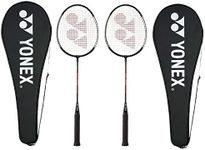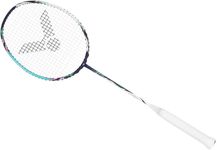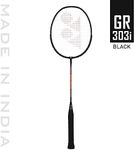Buying Guide for the Best Badminton Rackets
Choosing the right badminton racket can make a big difference in your playing experience, whether you’re a beginner or an advanced player. The best racket for you depends on your playing style, physical strength, and what you want to achieve on the court. Understanding the key specifications will help you find a racket that feels comfortable, enhances your strengths, and supports your improvement.WeightThe weight of a badminton racket affects how easy it is to swing and control. Lighter rackets (usually 80-85 grams) are easier to handle and are great for quick reactions and fast play, making them suitable for beginners or players who like to play doubles. Heavier rackets (around 86-92 grams) provide more power and stability, which can benefit singles players or those who rely on strong smashes. To pick the right weight, consider your strength and playing style: if you value speed and agility, go lighter; if you want more power and stability, go heavier.
Balance PointThe balance point refers to where the weight is distributed along the racket. Head-heavy rackets have more weight towards the top, giving you extra power for smashes and clears, which is good for aggressive players. Head-light rackets have more weight towards the handle, making them easier to maneuver and better for quick net play and defense. Even-balanced rackets offer a mix of both, suitable for all-round players. Think about whether you prefer powerful shots or quick movements to decide which balance suits you best.
Flexibility (Shaft Flex)The flexibility of the racket’s shaft affects how much it bends during a swing. A flexible shaft bends more, helping generate power with less effort, which is helpful for beginners or players with slower swings. A stiff shaft bends less, offering more control and accuracy, which is preferred by advanced players with faster swings. If you’re just starting or have a slower swing, a flexible shaft can help you get more power. If you’re experienced and want precision, go for a stiffer shaft.
Grip SizeGrip size is the thickness of the handle and affects how comfortably you can hold and control the racket. Smaller grips allow for more finger control and quick wrist movements, which is good for players who use a lot of wrist action. Larger grips provide a firmer hold and are better for players who use more arm power. To choose the right grip size, try holding different sizes and see which feels most comfortable and secure in your hand.
String TensionString tension refers to how tightly the strings are strung on the racket. Lower tension (18-22 lbs) gives a larger sweet spot and more power, making it easier for beginners to hit the shuttle. Higher tension (23-28 lbs or more) offers more control and accuracy but requires better technique and strength. If you’re new to badminton, start with lower tension for easier play. As you improve, you can try higher tension for more precise shots.
Frame MaterialThe material of the racket frame affects its durability, weight, and performance. Most rackets are made from graphite, aluminum, or a mix of advanced materials. Graphite rackets are lightweight and strong, suitable for most players. Aluminum rackets are heavier and more affordable, often chosen by beginners. Advanced materials like carbon fiber offer the best performance but are usually found in high-end rackets. Choose a material that matches your level and how often you play.



















